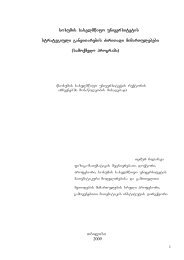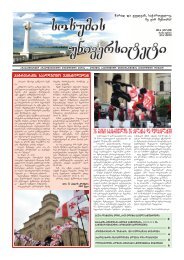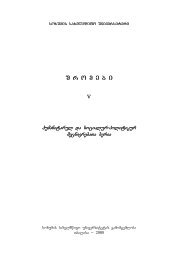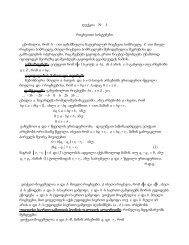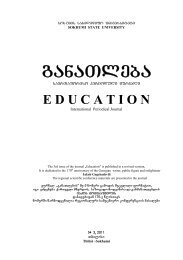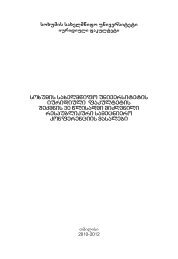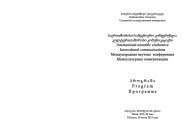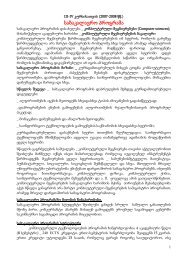- Page 1 and 2: soxumis saxelmwifo universitetisoxu
- Page 3 and 4: SOKHUMI STATE UNIVERSITYSOKHUMI STA
- Page 5 and 6: s a r C e v ielizbar nadaraia, petr
- Page 7 and 8: soxumis saxelmwifo universitetis Sr
- Page 9 and 10: arametrul SefasebaTa kvadratuli gad
- Page 11 and 12: sadisertacio sabWom erTxmad, faruli
- Page 13 and 14: F xThe problem consists in estimati
- Page 15 and 16: 11,x 0,1 ,1 x u KduF2x 1h h0
- Page 17 and 18: Proof. We have 11h 1sup x u1 Kdu
- Page 19 and 20: and, by virtue of (9),S2 n 0 as n
- Page 21 and 22: 1 F2nn 1O nh uniformly with respect
- Page 23 and 24: Tn2 1aang1a2ag1d2 dxN0, ,x FˆxFxu
- Page 25 and 26: Analogously,1n 0 as n . (30)Now l
- Page 27 and 28: (2) In the conditions of the item (
- Page 29 and 30: Tndt W t a11. (39)To prove (39), i
- Page 31 and 32: Let be the critical value, G .
- Page 33 and 34: soxumis saxelmwifo universitetis Sr
- Page 35 and 36: which we will try to overcome by as
- Page 37 and 38: wheretaket u2t b a 1p ,
- Page 39 and 40: Let us study the expression (6) for
- Page 41 and 42: may be negative. This mayhappen in
- Page 43 and 44: elizbar nadaraia, mzia facacia,grig
- Page 45 and 46: applications from the view-point of
- Page 47 and 48: ample, Mankiewicz generator, Baker
- Page 49: ( ii ) (" x)( x О Ў Ґ \ И B Ю
- Page 53 and 54: soxumis saxelmwifo universitetis Sr
- Page 55 and 56: Let ,...kw represent the Walsh func
- Page 57 and 58: a)measureonb) conjugate Fejйr mean
- Page 59 and 60: 1 1 1K m l D m kl1l2 /212/3l2 2k2m
- Page 61 and 62: mes x y I D D x y c2 2/3,2/3m{( , )
- Page 63 and 64: REFERENCES1. A. Garsia. Topic in al
- Page 65 and 66: soxumis saxelmwifo universitetis Sr
- Page 67 and 68: - PR - is an orthogonal cylinder,
- Page 69 and 70: g( ) :[0,2h] [0,2h](4)and if h = 1
- Page 71 and 72: •nGeneralized Möbius Listing's b
- Page 73 and 74: n- n - the “Number or twisting”
- Page 75 and 76: nn n Rcos sin( ) sin cos( );2
- Page 77 and 78: L( , ) = 0;M ( , ) =2N( , ) =nR
- Page 79 and 80: Definition 3. If the “B-line” i
- Page 81 and 82: T TˆTˆB,kB,k Tˆ2k1ˆ , ˆ ˆ
- Page 83 and 84: Let us consider now the general cas
- Page 85 and 86: nTheorem 2. If the GML 2 surface is
- Page 87 and 88: of the components is anGML 2 and th
- Page 89 and 90: the tangential vectors of the new o
- Page 91 and 92: soxumis saxelmwifo universitetis Sr
- Page 93 and 94: tion of experts which can to wage i
- Page 95 and 96: considers an antagonism case as equ
- Page 97 and 98: 3. Model of ignoring of an opposite
- Page 99 and 100: N20 NN2(t)=10 te +2( N N ) t 210
- Page 101 and 102:
At t [ 0, ), N3(t ) , when t .
- Page 103 and 104:
N220N 10+ N210 N20 t2De N10 N201t1
- Page 105 and 106:
Let's really copy (3.5) - (3.7) as
- Page 107 and 108:
As to the international organizatio
- Page 109 and 110:
2 N0 t ln N2010 N N1020828(4.33
- Page 111 and 112:
5. M. Hananashvili. Information str
- Page 113 and 114:
soxumis saxelmwifo universitetis Sr
- Page 115 and 116:
Russia, though with delay, operates
- Page 117 and 118:
al organizations (the United Nation
- Page 119 and 120:
The third side initially does not s
- Page 121 and 122:
3. D = 2 8< 0N230N3(t )=2N10 N202
- Page 123 and 124:
2N10 2N30The sign N1(t)at big t def
- Page 125:
1 N10 N20t = Dln N30N 10N20
- Page 128 and 129:
whenceN210N 20 1e 2t- A= 0 ,e 2t =
- Page 130 and 131:
As in the right part of the last pa
- Page 132 and 133:
then, the antagonistic sides under
- Page 134 and 135:
1
- Page 136 and 137:
t0F .Thus, when,30The lemma is prov
- Page 138 and 139:
As for N1(t ), N1(t ) , at t ,
- Page 140 and 141:
наукових праць Інс
- Page 142 and 143:
soxumis saxelmwifo universitetis Sr
- Page 144 and 145:
1. Let, D x x, x2,,x ,2. The state
- Page 146 and 147:
Let h hbe the partial-time mesh o
- Page 148 and 149:
148 (1)Let's notice that W 2 -- is
- Page 150 and 151:
p 1By t F,where0 0B E R E , y y
- Page 152 and 153:
theorem 3.1 it is easily possible t
- Page 154 and 155:
hamlet melaZeorSriani faqtorizebuli
- Page 156 and 157:
ods used for numerical solution of
- Page 158 and 159:
u(1)x1 b2b1 x1( x1) 1 2, (7)b b b
- Page 160 and 161:
x b b x b x 1 2 1 1 1 1u( x1) 1
- Page 162 and 163:
( N )2 1 ( N )2 2 y 0 , z 0 , (20)(
- Page 164 and 165:
21k(1) ( i)z h h f x2andx2b21 N
- Page 166 and 167:
z(1) z(1)1 z(1)2b2 xb2b1 bxb(1)22b2
- Page 168 and 169:
sadac − wibos sigrZea, xolo f( x
- Page 170 and 171:
170 Tavisufali adamianebis raodenob
- Page 172 and 173:
momentSi marTvadi adamianebis raode
- Page 174 and 175:
(2.9)am SemTxvevaSi, (2.9)-is anali
- Page 176 and 177:
, miiswrafvis nulisken (Zlieri zewo
- Page 178 and 179:
da sabolood miviRebT tolobasamrigad
- Page 180 and 181:
180TEMUR CHILACHAVA, TSIALA DZIDZIG
- Page 182 and 183:
ciala ZiZiguri - soxumis saxelmwifo
- Page 184 and 185:
Jurnalis TematikaJurnali aqveynebs
- Page 186 and 187:
soxumis saxelmwifo universitetis Sr



